Antibody data
- Antibody Data
- Antigen structure
- References [62]
- Comments [0]
- Validations
- Flow cytometry [2]
- Other assay [9]
Submit
Validation data
Reference
Comment
Report error
- Product number
- 14-9922-80 - Provider product page

- Provider
- Invitrogen Antibodies
- Product name
- CD282 (TLR2) Monoclonal Antibody (TL2.1), eBioscience™
- Antibody type
- Monoclonal
- Antigen
- Other
- Description
- Description: The TL2.1 monoclonal antibody reacts with human Toll-like receptor 2 (TLR2). To date, at least ten members of the Toll family have been identified in human. This family of type I transmembrane proteins is characterized by an extracellular domain with leucine-rich repeats and a cytoplasmic domain with homology to the type I IL-1 receptor. Two of these receptors, TLR2 and TLR4, are pattern recognition receptors and signaling molecules in response to bacterial lipoproteins and have been implicated in innate immunity and inflammation. TLR2 is expressed by peripheral blood monocytes and is responsible for distinguishing different pathogens. TL2.1, a blocking antibody, has been used to study the role of TLR-2 as a pattern recognition receptor in microbial lipoprotein/lipopeptide induced cytokine production from human peripheral blood mononuclear cells. TL2.1 has been reported to immunoprecipitate human TLR2 (~90 kDa) from PBMC and HMEC. Applications Reported: The TL2.1 antibody has been reported for use in flow cytometric analysis, immunoprecipitation, immunoblotting (WB), and immunohistochemical staining of frozen as well as paraffin embedded tissue sections. It has also been reported in blocking of TLR2-mediated cytokine production. The reported applicability of TL2.1 for immunoblotting and histochemistry may require high expression levels of TLR2 and has not been confirmed in our tests. (Please use Functional Grade purified TL2.1, Product # 16-9922, in functional assays). Applications Tested: The TL2.1 antibody has been tested by flow cytometric analysis of normal human peripheral blood cells and can be used at less than or equal to 2 µg per test. A test is defined as the amount (µg) of antibody that will stain a cell sample in a final volume of 100 µL. Cell number should be determined empirically but can range from 10^5 to 10^8 cells/test. It is recommended that the antibody be carefully titrated for optimal performance in the assay of interest. Purity: Greater than 90%, as determined by SDS-PAGE. Aggregation: Less than 10%, as determined by HPLC. Filtration: 0.2 µm post-manufacturing filtered.
- Reactivity
- Human
- Host
- Mouse
- Isotype
- IgG
- Antibody clone number
- TL2.1
- Vial size
- 25 μg
- Concentration
- 0.5 mg/mL
- Storage
- 4°C
Submitted references Peptidoglycan mediates Leptospira outer membrane protein Loa22 to toll-like receptor 2 for inflammatory interaction: a novel innate immune recognition.
HIV-1 Tat - TLR4/MD2 interaction drives the expression of IDO-1 in monocytes derived dendritic cells through NF-κB dependent pathway.
TLR2 on blood monocytes senses dengue virus infection and its expression correlates with disease pathogenesis.
Mannan-Binding Lectin Suppresses Peptidoglycan-Induced TLR2 Activation and Inflammatory Responses.
Dietary Toll-Like Receptor Stimulants Promote Hepatic Inflammation and Impair Reverse Cholesterol Transport in Mice via Macrophage-Dependent Interleukin-1 Production.
Altered PGE2-EP2 is associated with an excessive immune response in HBV-related acute-on-chronic liver failure.
Interferon-β induced in female genital epithelium by HIV-1 glycoprotein 120 via Toll-like-receptor 2 pathway acts to protect the mucosal barrier.
Activation of the Toll‑like receptor 2 signaling pathway inhibits the proliferation of HCC cells in vitro.
Toll-like receptor chaperone HSP90B1 and the immune response to Mycobacteria.
n-butanol extract from Folium isatidis inhibits the lipopolysaccharide-induced downregulation of CXCR1 and CXCR2 on human neutrophils.
CCL20 and Beta-Defensin 2 Production by Human Lung Epithelial Cells and Macrophages in Response to Brucella abortus Infection.
The antimicrobial protein short palate, lung, and nasal epithelium clone 1 (SPLUNC1) is differentially modulated in eosinophilic and noneosinophilic chronic rhinosinusitis with nasal polyps.
Mannan-binding lectin inhibits Candida albicans-induced cellular responses in PMA-activated THP-1 cells through Toll-like receptor 2 and Toll-like receptor 4.
HIV-1 Tat protein binds to TLR4-MD2 and signals to induce TNF-α and IL-10.
The 19 kDa Mycobacterium tuberculosis lipoprotein (LpqH) induces macrophage apoptosis through extrinsic and intrinsic pathways: a role for the mitochondrial apoptosis-inducing factor.
Hepatitis C virus core protein induces fibrogenic actions of hepatic stellate cells via toll-like receptor 2.
Potential role of fibroblast-like synoviocytes in joint damage induced by Brucella abortus infection through production and induction of matrix metalloproteinases.
Human monocytes promote Th1 and Th17 responses to Streptococcus pneumoniae.
Neisseria meningitidis capsular polysaccharides induce inflammatory responses via TLR2 and TLR4-MD-2.
Stepwise release of biologically active HMGB1 during HSV-2 infection.
Role of hyaluronan and hyaluronan-binding proteins in human asthma.
Lack of effect of glutamine administration to boost the innate immune system response in trauma patients in the intensive care unit.
Involvement of TLR2 and TLR4 in cell responses to Rickettsia akari.
Neisseria gonorrhoeae enhances HIV-1 infection of primary resting CD4+ T cells through TLR2 activation.
Legionella lipoprotein activates toll-like receptor 2 and induces cytokine production and expression of costimulatory molecules in peritoneal macrophages.
Epigenetic regulation of TLR4 gene expression in intestinal epithelial cells for the maintenance of intestinal homeostasis.
Responses to amyloids of microbial and host origin are mediated through toll-like receptor 2.
Toll-like receptor-2 mediates inflammation and matrix degradation in human atherosclerosis.
TLR2 promotes Th2/Th17 responses via TLR4 and TLR7/8 by abrogating the type I IFN amplification loop.
Pathogen induction of CXCR4/TLR2 cross-talk impairs host defense function.
Effects of vitamin D on expression of Toll-like receptors of monocytes from patients with Behcet's disease.
Induction of beta defensin 2 by NTHi requires TLR2 mediated MyD88 and IRAK-TRAF6-p38MAPK signaling pathway in human middle ear epithelial cells.
Antibodies specific for human or murine Toll-like receptors detect canine leukocytes by flow cytometry.
Age-related differences in sensitivity of peripheral blood monocytes to lipopolysaccharide and Staphylococcus aureus toxin B in atopic dermatitis.
Potential role for Toll-like receptor 4 in mediating Escherichia coli maltose-binding protein activation of dendritic cells.
Intracellular signaling mechanisms regulating toll-like receptor-mediated activation of eosinophils.
Toll-like receptor 3 (TLR3): a new marker of canine monocytes-derived dendritic cells (cMo-DC).
Disparate innate immune responses to persistent and acute Chlamydia pneumoniae infection in chronic obstructive pulmonary disease.
Ultraviolet-inactivated human cytomegalovirus induces placental syncytiotrophoblast apoptosis in a Toll-like receptor-2 and tumour necrosis factor-alpha dependent manner.
Up-regulation of gamma interferon receptor expression due to Chlamydia-toll-like receptor interaction does not enhance signal transducer and activator of transcription 1 signaling.
Toll-like receptor 2 mediates cellular activation by the B subunits of type II heat-labile enterotoxins.
Surface calreticulin mediates muramyl dipeptide-induced apoptosis in RK13 cells.
Endocarditis-associated oral streptococci promote rapid differentiation of monocytes into mature dendritic cells.
Nystatin induces secretion of interleukin (IL)-1beta, IL-8, and tumor necrosis factor alpha by a toll-like receptor-dependent mechanism.
Toll-like receptor 2 expression on human conjunctival epithelial cells: a pathway for Staphylococcus aureus involvement in chronic ocular proinflammatory responses.
Intracellularly expressed TLR2s and TLR4s contribution to an immunosilent environment at the ocular mucosal epithelium.
Intracellularly expressed TLR2s and TLR4s contribution to an immunosilent environment at the ocular mucosal epithelium.
Phenotypic and functional deficiencies of monocyte-derived dendritic cells in systemic lupus erythematosus (SLE) patients.
Expression of Toll-like receptor 2 on CD16+ blood monocytes and synovial tissue macrophages in rheumatoid arthritis.
Downregulation of the DNA-binding activity of nuclear factor-kappaB p65 subunit in Porphyromonas gingivalis fimbria-induced tolerance.
Downregulation of the DNA-binding activity of nuclear factor-kappaB p65 subunit in Porphyromonas gingivalis fimbria-induced tolerance.
Yeast-derived human immunodeficiency virus type 1 p55(gag) virus-like particles activate dendritic cells (DCs) and induce perforin expression in Gag-specific CD8(+) T cells by cross-presentation of DCs.
Yeast-derived human immunodeficiency virus type 1 p55(gag) virus-like particles activate dendritic cells (DCs) and induce perforin expression in Gag-specific CD8(+) T cells by cross-presentation of DCs.
The urokinase receptor can be induced by Borrelia burgdorferi through receptors of the innate immune system.
The urokinase receptor can be induced by Borrelia burgdorferi through receptors of the innate immune system.
Bacterial peptidoglycans but not CpG oligodeoxynucleotides activate synovial fibroblasts by toll-like receptor signaling.
Immunohistochemical localization of Toll-like receptors 2 and 4 in gingival tissue from patients with periodontitis.
Immunohistochemical localization of Toll-like receptors 2 and 4 in gingival tissue from patients with periodontitis.
Toll-like receptor 2 is expressed by alveolar epithelial cells type II and macrophages in the human lung.
Bacterial lipopolysaccharide and IFN-gamma induce Toll-like receptor 2 and Toll-like receptor 4 expression in human endothelial cells: role of NF-kappa B activation.
Human toll-like receptor 2 mediates monocyte activation by Listeria monocytogenes, but not by group B streptococci or lipopolysaccharide.
Toll-like receptor 2 functions as a pattern recognition receptor for diverse bacterial products.
Hsu SH, Chang MY, Lin SM, Ko YC, Chou LF, Tian YC, Hung CC, Yang CW
Scientific reports 2021 Jan 13;11(1):1064
Scientific reports 2021 Jan 13;11(1):1064
HIV-1 Tat - TLR4/MD2 interaction drives the expression of IDO-1 in monocytes derived dendritic cells through NF-κB dependent pathway.
Bahraoui E, Serrero M, Planès R
Scientific reports 2020 May 18;10(1):8177
Scientific reports 2020 May 18;10(1):8177
TLR2 on blood monocytes senses dengue virus infection and its expression correlates with disease pathogenesis.
Aguilar-Briseño JA, Upasani V, Ellen BMT, Moser J, Pauzuolis M, Ruiz-Silva M, Heng S, Laurent D, Choeung R, Dussart P, Cantaert T, Smit JM, Rodenhuis-Zybert IA
Nature communications 2020 Jun 23;11(1):3177
Nature communications 2020 Jun 23;11(1):3177
Mannan-Binding Lectin Suppresses Peptidoglycan-Induced TLR2 Activation and Inflammatory Responses.
Wang F, Li Y, Yang C, Mu Y, Wang Y, Zhang W, Yang Y, Chen C, Song S, Shen Z, Wang W, Li J, Zhai J, Guo K, Sun R, Yu L, Wang M
Mediators of inflammation 2019;2019:1349784
Mediators of inflammation 2019;2019:1349784
Dietary Toll-Like Receptor Stimulants Promote Hepatic Inflammation and Impair Reverse Cholesterol Transport in Mice via Macrophage-Dependent Interleukin-1 Production.
Faraj TA, Stover C, Erridge C
Frontiers in immunology 2019;10:1404
Frontiers in immunology 2019;10:1404
Altered PGE2-EP2 is associated with an excessive immune response in HBV-related acute-on-chronic liver failure.
Wang Y, Chen C, Qi J, Wu F, Guan J, Chen Z, Zhu H
Journal of translational medicine 2019 Mar 19;17(1):93
Journal of translational medicine 2019 Mar 19;17(1):93
Interferon-β induced in female genital epithelium by HIV-1 glycoprotein 120 via Toll-like-receptor 2 pathway acts to protect the mucosal barrier.
Nazli A, Dizzell S, Zahoor MA, Ferreira VH, Kafka J, Woods MW, Ouellet M, Ashkar AA, Tremblay MJ, Bowdish DM, Kaushic C
Cellular & molecular immunology 2019 Feb;16(2):178-194
Cellular & molecular immunology 2019 Feb;16(2):178-194
Activation of the Toll‑like receptor 2 signaling pathway inhibits the proliferation of HCC cells in vitro.
Chen Y, Huang Z, Chen X, Ye H
Oncology reports 2019 Dec;42(6):2267-2278
Oncology reports 2019 Dec;42(6):2267-2278
Toll-like receptor chaperone HSP90B1 and the immune response to Mycobacteria.
Graustein AD, Misch EA, Musvosvi M, Shey M, Shah JA, Seshadri C, Ajuogu A, Bowman K, Mulenga H, Veldsman A, Hanekom WA, Hatherill M, Scriba TJ, Hawn TR
PloS one 2018;13(12):e0208940
PloS one 2018;13(12):e0208940
n-butanol extract from Folium isatidis inhibits the lipopolysaccharide-induced downregulation of CXCR1 and CXCR2 on human neutrophils.
Wu B, Wang L, Jiang L, Dong L, Xu F, Lu Y, Jin J, Wang Z, Liang G, Shan X
Molecular medicine reports 2018 Jan;17(1):179-185
Molecular medicine reports 2018 Jan;17(1):179-185
CCL20 and Beta-Defensin 2 Production by Human Lung Epithelial Cells and Macrophages in Response to Brucella abortus Infection.
Hielpos MS, Ferrero MC, Fernández AG, Bonetto J, Giambartolomei GH, Fossati CA, Baldi PC
PloS one 2015;10(10):e0140408
PloS one 2015;10(10):e0140408
The antimicrobial protein short palate, lung, and nasal epithelium clone 1 (SPLUNC1) is differentially modulated in eosinophilic and noneosinophilic chronic rhinosinusitis with nasal polyps.
Wei Y, Xia W, Ye X, Fan Y, Shi J, Wen W, Yang P, Li H, Nasal Health Group, China (NHGC)
The Journal of allergy and clinical immunology 2014 Feb;133(2):420-8
The Journal of allergy and clinical immunology 2014 Feb;133(2):420-8
Mannan-binding lectin inhibits Candida albicans-induced cellular responses in PMA-activated THP-1 cells through Toll-like receptor 2 and Toll-like receptor 4.
Wang M, Wang F, Yang J, Zhao D, Wang H, Shao F, Wang W, Sun R, Ling M, Zhai J, Song S
PloS one 2013;8(12):e83517
PloS one 2013;8(12):e83517
HIV-1 Tat protein binds to TLR4-MD2 and signals to induce TNF-α and IL-10.
Ben Haij N, Leghmari K, Planès R, Thieblemont N, Bahraoui E
Retrovirology 2013 Oct 28;10:123
Retrovirology 2013 Oct 28;10:123
The 19 kDa Mycobacterium tuberculosis lipoprotein (LpqH) induces macrophage apoptosis through extrinsic and intrinsic pathways: a role for the mitochondrial apoptosis-inducing factor.
Sánchez A, Espinosa P, García T, Mancilla R
Clinical & developmental immunology 2012;2012:950503
Clinical & developmental immunology 2012;2012:950503
Hepatitis C virus core protein induces fibrogenic actions of hepatic stellate cells via toll-like receptor 2.
Coenen M, Nischalke HD, Krämer B, Langhans B, Glässner A, Schulte D, Körner C, Sauerbruch T, Nattermann J, Spengler U
Laboratory investigation; a journal of technical methods and pathology 2011 Sep;91(9):1375-82
Laboratory investigation; a journal of technical methods and pathology 2011 Sep;91(9):1375-82
Potential role of fibroblast-like synoviocytes in joint damage induced by Brucella abortus infection through production and induction of matrix metalloproteinases.
Scian R, Barrionuevo P, Giambartolomei GH, De Simone EA, Vanzulli SI, Fossati CA, Baldi PC, Delpino MV
Infection and immunity 2011 Sep;79(9):3619-32
Infection and immunity 2011 Sep;79(9):3619-32
Human monocytes promote Th1 and Th17 responses to Streptococcus pneumoniae.
Olliver M, Hiew J, Mellroth P, Henriques-Normark B, Bergman P
Infection and immunity 2011 Oct;79(10):4210-7
Infection and immunity 2011 Oct;79(10):4210-7
Neisseria meningitidis capsular polysaccharides induce inflammatory responses via TLR2 and TLR4-MD-2.
Zughaier SM
Journal of leukocyte biology 2011 Mar;89(3):469-80
Journal of leukocyte biology 2011 Mar;89(3):469-80
Stepwise release of biologically active HMGB1 during HSV-2 infection.
Borde C, Barnay-Verdier S, Gaillard C, Hocini H, Maréchal V, Gozlan J
PloS one 2011 Jan 19;6(1):e16145
PloS one 2011 Jan 19;6(1):e16145
Role of hyaluronan and hyaluronan-binding proteins in human asthma.
Liang J, Jiang D, Jung Y, Xie T, Ingram J, Church T, Degan S, Leonard M, Kraft M, Noble PW
The Journal of allergy and clinical immunology 2011 Aug;128(2):403-411.e3
The Journal of allergy and clinical immunology 2011 Aug;128(2):403-411.e3
Lack of effect of glutamine administration to boost the innate immune system response in trauma patients in the intensive care unit.
Pérez-Bárcena J, Crespí C, Regueiro V, Marsé P, Raurich JM, Ibáñez J, García de Lorenzo-Mateos A, Bengoechea JA
Critical care (London, England) 2010;14(6):R233
Critical care (London, England) 2010;14(6):R233
Involvement of TLR2 and TLR4 in cell responses to Rickettsia akari.
Quevedo-Diaz MA, Song C, Xiong Y, Chen H, Wahl LM, Radulovic S, Medvedev AE
Journal of leukocyte biology 2010 Oct;88(4):675-85
Journal of leukocyte biology 2010 Oct;88(4):675-85
Neisseria gonorrhoeae enhances HIV-1 infection of primary resting CD4+ T cells through TLR2 activation.
Ding J, Rapista A, Teleshova N, Mosoyan G, Jarvis GA, Klotman ME, Chang TL
Journal of immunology (Baltimore, Md. : 1950) 2010 Mar 15;184(6):2814-24
Journal of immunology (Baltimore, Md. : 1950) 2010 Mar 15;184(6):2814-24
Legionella lipoprotein activates toll-like receptor 2 and induces cytokine production and expression of costimulatory molecules in peritoneal macrophages.
Shim HK, Kim JY, Kim MJ, Sim HS, Park DW, Sohn JW, Kim MJ
Experimental & molecular medicine 2009 Oct 31;41(10):687-94
Experimental & molecular medicine 2009 Oct 31;41(10):687-94
Epigenetic regulation of TLR4 gene expression in intestinal epithelial cells for the maintenance of intestinal homeostasis.
Takahashi K, Sugi Y, Hosono A, Kaminogawa S
Journal of immunology (Baltimore, Md. : 1950) 2009 Nov 15;183(10):6522-9
Journal of immunology (Baltimore, Md. : 1950) 2009 Nov 15;183(10):6522-9
Responses to amyloids of microbial and host origin are mediated through toll-like receptor 2.
Tükel C, Wilson RP, Nishimori JH, Pezeshki M, Chromy BA, Bäumler AJ
Cell host & microbe 2009 Jul 23;6(1):45-53
Cell host & microbe 2009 Jul 23;6(1):45-53
Toll-like receptor-2 mediates inflammation and matrix degradation in human atherosclerosis.
Monaco C, Gregan SM, Navin TJ, Foxwell BM, Davies AH, Feldmann M
Circulation 2009 Dec 15;120(24):2462-9
Circulation 2009 Dec 15;120(24):2462-9
TLR2 promotes Th2/Th17 responses via TLR4 and TLR7/8 by abrogating the type I IFN amplification loop.
Wenink MH, Santegoets KC, Broen JC, van Bon L, Abdollahi-Roodsaz S, Popa C, Huijbens R, Remijn T, Lubberts E, van Riel PL, van den Berg WB, Radstake TR
Journal of immunology (Baltimore, Md. : 1950) 2009 Dec 1;183(11):6960-70
Journal of immunology (Baltimore, Md. : 1950) 2009 Dec 1;183(11):6960-70
Pathogen induction of CXCR4/TLR2 cross-talk impairs host defense function.
Hajishengallis G, Wang M, Liang S, Triantafilou M, Triantafilou K
Proceedings of the National Academy of Sciences of the United States of America 2008 Sep 9;105(36):13532-7
Proceedings of the National Academy of Sciences of the United States of America 2008 Sep 9;105(36):13532-7
Effects of vitamin D on expression of Toll-like receptors of monocytes from patients with Behcet's disease.
Do JE, Kwon SY, Park S, Lee ES
Rheumatology (Oxford, England) 2008 Jun;47(6):840-8
Rheumatology (Oxford, England) 2008 Jun;47(6):840-8
Induction of beta defensin 2 by NTHi requires TLR2 mediated MyD88 and IRAK-TRAF6-p38MAPK signaling pathway in human middle ear epithelial cells.
Lee HY, Takeshita T, Shimada J, Akopyan A, Woo JI, Pan H, Moon SK, Andalibi A, Park RK, Kang SH, Kang SS, Gellibolian R, Lim DJ
BMC infectious diseases 2008 Jun 25;8:87
BMC infectious diseases 2008 Jun 25;8:87
Antibodies specific for human or murine Toll-like receptors detect canine leukocytes by flow cytometry.
Burgener IA, Jungi TW
Veterinary immunology and immunopathology 2008 Jul 15;124(1-2):184-91
Veterinary immunology and immunopathology 2008 Jul 15;124(1-2):184-91
Age-related differences in sensitivity of peripheral blood monocytes to lipopolysaccharide and Staphylococcus aureus toxin B in atopic dermatitis.
Mandron M, Ariès MF, Boralevi F, Martin H, Charveron M, Taieb A, Davrinche C
The Journal of investigative dermatology 2008 Apr;128(4):882-9
The Journal of investigative dermatology 2008 Apr;128(4):882-9
Potential role for Toll-like receptor 4 in mediating Escherichia coli maltose-binding protein activation of dendritic cells.
Fernandez S, Palmer DR, Simmons M, Sun P, Bisbing J, McClain S, Mani S, Burgess T, Gunther V, Sun W
Infection and immunity 2007 Mar;75(3):1359-63
Infection and immunity 2007 Mar;75(3):1359-63
Intracellular signaling mechanisms regulating toll-like receptor-mediated activation of eosinophils.
Wong CK, Cheung PF, Ip WK, Lam CW
American journal of respiratory cell and molecular biology 2007 Jul;37(1):85-96
American journal of respiratory cell and molecular biology 2007 Jul;37(1):85-96
Toll-like receptor 3 (TLR3): a new marker of canine monocytes-derived dendritic cells (cMo-DC).
Bonnefont-Rebeix C, Marchal T, Bernaud J, Pin JJ, Leroux C, Lebecque S, Chabanne L, Rigal D
Veterinary immunology and immunopathology 2007 Jul 15;118(1-2):134-9
Veterinary immunology and immunopathology 2007 Jul 15;118(1-2):134-9
Disparate innate immune responses to persistent and acute Chlamydia pneumoniae infection in chronic obstructive pulmonary disease.
Droemann D, Rupp J, Goldmann T, Uhlig U, Branscheid D, Vollmer E, Kujath P, Zabel P, Dalhoff K
American journal of respiratory and critical care medicine 2007 Apr 15;175(8):791-7
American journal of respiratory and critical care medicine 2007 Apr 15;175(8):791-7
Ultraviolet-inactivated human cytomegalovirus induces placental syncytiotrophoblast apoptosis in a Toll-like receptor-2 and tumour necrosis factor-alpha dependent manner.
Chan G, Guilbert LJ
The Journal of pathology 2006 Sep;210(1):111-20
The Journal of pathology 2006 Sep;210(1):111-20
Up-regulation of gamma interferon receptor expression due to Chlamydia-toll-like receptor interaction does not enhance signal transducer and activator of transcription 1 signaling.
Shirey KA, Jung JY, Carlin JM
Infection and immunity 2006 Dec;74(12):6877-84
Infection and immunity 2006 Dec;74(12):6877-84
Toll-like receptor 2 mediates cellular activation by the B subunits of type II heat-labile enterotoxins.
Hajishengallis G, Tapping RI, Martin MH, Nawar H, Lyle EA, Russell MW, Connell TD
Infection and immunity 2005 Mar;73(3):1343-9
Infection and immunity 2005 Mar;73(3):1343-9
Surface calreticulin mediates muramyl dipeptide-induced apoptosis in RK13 cells.
Chen D, Texada DE, Duggan C, Liang C, Reden TB, Kooragayala LM, Langford MP
The Journal of biological chemistry 2005 Jun 10;280(23):22425-36
The Journal of biological chemistry 2005 Jun 10;280(23):22425-36
Endocarditis-associated oral streptococci promote rapid differentiation of monocytes into mature dendritic cells.
Hahn CL, Schenkein HA, Tew JG
Infection and immunity 2005 Aug;73(8):5015-21
Infection and immunity 2005 Aug;73(8):5015-21
Nystatin induces secretion of interleukin (IL)-1beta, IL-8, and tumor necrosis factor alpha by a toll-like receptor-dependent mechanism.
Razonable RR, Henault M, Watson HL, Paya CV
Antimicrobial agents and chemotherapy 2005 Aug;49(8):3546-9
Antimicrobial agents and chemotherapy 2005 Aug;49(8):3546-9
Toll-like receptor 2 expression on human conjunctival epithelial cells: a pathway for Staphylococcus aureus involvement in chronic ocular proinflammatory responses.
Cook EB, Stahl JL, Esnault S, Barney NP, Graziano FM
Annals of allergy, asthma & immunology : official publication of the American College of Allergy, Asthma, & Immunology 2005 Apr;94(4):486-97
Annals of allergy, asthma & immunology : official publication of the American College of Allergy, Asthma, & Immunology 2005 Apr;94(4):486-97
Intracellularly expressed TLR2s and TLR4s contribution to an immunosilent environment at the ocular mucosal epithelium.
Ueta M, Nochi T, Jang MH, Park EJ, Igarashi O, Hino A, Kawasaki S, Shikina T, Hiroi T, Kinoshita S, Kiyono H
Journal of immunology (Baltimore, Md. : 1950) 2004 Sep 1;173(5):3337-47
Journal of immunology (Baltimore, Md. : 1950) 2004 Sep 1;173(5):3337-47
Intracellularly expressed TLR2s and TLR4s contribution to an immunosilent environment at the ocular mucosal epithelium.
Ueta M, Nochi T, Jang MH, Park EJ, Igarashi O, Hino A, Kawasaki S, Shikina T, Hiroi T, Kinoshita S, Kiyono H
Journal of immunology (Baltimore, Md. : 1950) 2004 Sep 1;173(5):3337-47
Journal of immunology (Baltimore, Md. : 1950) 2004 Sep 1;173(5):3337-47
Phenotypic and functional deficiencies of monocyte-derived dendritic cells in systemic lupus erythematosus (SLE) patients.
Köller M, Zwölfer B, Steiner G, Smolen JS, Scheinecker C
International immunology 2004 Nov;16(11):1595-604
International immunology 2004 Nov;16(11):1595-604
Expression of Toll-like receptor 2 on CD16+ blood monocytes and synovial tissue macrophages in rheumatoid arthritis.
Iwahashi M, Yamamura M, Aita T, Okamoto A, Ueno A, Ogawa N, Akashi S, Miyake K, Godowski PJ, Makino H
Arthritis and rheumatism 2004 May;50(5):1457-67
Arthritis and rheumatism 2004 May;50(5):1457-67
Downregulation of the DNA-binding activity of nuclear factor-kappaB p65 subunit in Porphyromonas gingivalis fimbria-induced tolerance.
Hajishengallis G, Genco RJ
Infection and immunity 2004 Feb;72(2):1188-91
Infection and immunity 2004 Feb;72(2):1188-91
Downregulation of the DNA-binding activity of nuclear factor-kappaB p65 subunit in Porphyromonas gingivalis fimbria-induced tolerance.
Hajishengallis G, Genco RJ
Infection and immunity 2004 Feb;72(2):1188-91
Infection and immunity 2004 Feb;72(2):1188-91
Yeast-derived human immunodeficiency virus type 1 p55(gag) virus-like particles activate dendritic cells (DCs) and induce perforin expression in Gag-specific CD8(+) T cells by cross-presentation of DCs.
Tsunetsugu-Yokota Y, Morikawa Y, Isogai M, Kawana-Tachikawa A, Odawara T, Nakamura T, Grassi F, Autran B, Iwamoto A
Journal of virology 2003 Oct;77(19):10250-9
Journal of virology 2003 Oct;77(19):10250-9
Yeast-derived human immunodeficiency virus type 1 p55(gag) virus-like particles activate dendritic cells (DCs) and induce perforin expression in Gag-specific CD8(+) T cells by cross-presentation of DCs.
Tsunetsugu-Yokota Y, Morikawa Y, Isogai M, Kawana-Tachikawa A, Odawara T, Nakamura T, Grassi F, Autran B, Iwamoto A
Journal of virology 2003 Oct;77(19):10250-9
Journal of virology 2003 Oct;77(19):10250-9
The urokinase receptor can be induced by Borrelia burgdorferi through receptors of the innate immune system.
Coleman JL, Benach JL
Infection and immunity 2003 Oct;71(10):5556-64
Infection and immunity 2003 Oct;71(10):5556-64
The urokinase receptor can be induced by Borrelia burgdorferi through receptors of the innate immune system.
Coleman JL, Benach JL
Infection and immunity 2003 Oct;71(10):5556-64
Infection and immunity 2003 Oct;71(10):5556-64
Bacterial peptidoglycans but not CpG oligodeoxynucleotides activate synovial fibroblasts by toll-like receptor signaling.
Kyburz D, Rethage J, Seibl R, Lauener R, Gay RE, Carson DA, Gay S
Arthritis and rheumatism 2003 Mar;48(3):642-50
Arthritis and rheumatism 2003 Mar;48(3):642-50
Immunohistochemical localization of Toll-like receptors 2 and 4 in gingival tissue from patients with periodontitis.
Mori Y, Yoshimura A, Ukai T, Lien E, Espevik T, Hara Y
Oral microbiology and immunology 2003 Feb;18(1):54-8
Oral microbiology and immunology 2003 Feb;18(1):54-8
Immunohistochemical localization of Toll-like receptors 2 and 4 in gingival tissue from patients with periodontitis.
Mori Y, Yoshimura A, Ukai T, Lien E, Espevik T, Hara Y
Oral microbiology and immunology 2003 Feb;18(1):54-8
Oral microbiology and immunology 2003 Feb;18(1):54-8
Toll-like receptor 2 is expressed by alveolar epithelial cells type II and macrophages in the human lung.
Droemann D, Goldmann T, Branscheid D, Clark R, Dalhoff K, Zabel P, Vollmer E
Histochemistry and cell biology 2003 Feb;119(2):103-8
Histochemistry and cell biology 2003 Feb;119(2):103-8
Bacterial lipopolysaccharide and IFN-gamma induce Toll-like receptor 2 and Toll-like receptor 4 expression in human endothelial cells: role of NF-kappa B activation.
Faure E, Thomas L, Xu H, Medvedev A, Equils O, Arditi M
Journal of immunology (Baltimore, Md. : 1950) 2001 Feb 1;166(3):2018-24
Journal of immunology (Baltimore, Md. : 1950) 2001 Feb 1;166(3):2018-24
Human toll-like receptor 2 mediates monocyte activation by Listeria monocytogenes, but not by group B streptococci or lipopolysaccharide.
Flo TH, Halaas O, Lien E, Ryan L, Teti G, Golenbock DT, Sundan A, Espevik T
Journal of immunology (Baltimore, Md. : 1950) 2000 Feb 15;164(4):2064-9
Journal of immunology (Baltimore, Md. : 1950) 2000 Feb 15;164(4):2064-9
Toll-like receptor 2 functions as a pattern recognition receptor for diverse bacterial products.
Lien E, Sellati TJ, Yoshimura A, Flo TH, Rawadi G, Finberg RW, Carroll JD, Espevik T, Ingalls RR, Radolf JD, Golenbock DT
The Journal of biological chemistry 1999 Nov 19;274(47):33419-25
The Journal of biological chemistry 1999 Nov 19;274(47):33419-25
No comments: Submit comment
Supportive validation
- Submitted by
- Invitrogen Antibodies (provider)
- Main image
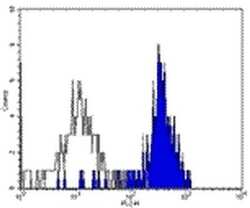
- Experimental details
- Human peripheral blood monocytes were stained with Anti-Human CD282 (TLR2) Purified followed by Anti-Mouse IgG FITC (Product # 11-4011-85). (Gated on normal peripheral monocytes).
- Submitted by
- Invitrogen Antibodies (provider)
- Main image
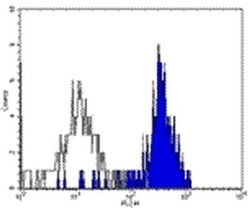
- Experimental details
- Human peripheral blood monocytes were stained with Anti-Human CD282 (TLR2) Purified followed by Anti-Mouse IgG FITC (Product # 11-4011-85). (Gated on normal peripheral monocytes).
Supportive validation
- Submitted by
- Invitrogen Antibodies (provider)
- Main image
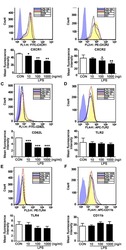
- Experimental details
- NULL
- Submitted by
- Invitrogen Antibodies (provider)
- Main image
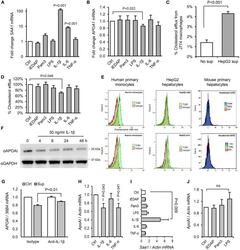
- Experimental details
- Figure 9 Interleukin-1beta plays a key role in the downregulation of RCT mediators by hepatocytes in response to products secreted by activated hepatic macrophages. (A,B) Human HepG2 hepatocytes increased serum amyloid A (SAA)-1, and reduced ApoAI, mRNA expression significantly in response to IL-1beta, but not stimulants of NOD1 (iEDAP), TLR2 (Pam 3 CSK 4 ), or TLR4 ( E. coli LPS). (C) Conditioned medium of HepG2 cells significantly increased the efflux of 3 H-radiolabelled cholesterol from J774 macrophages. (D) The capacity of conditioned media of HepG2 hepatocytes to accept 3 H-radiolabelled cholesterol effluxed from J774 macrophages was reduced significantly by IL-1beta, but not by IL-6, TNF-alpha, or stimulants of NOD1, TLR2, or TLR4. (E) Flow cytometry showed abundant surface TLR2 and TLR4 on human primary monocytes, but no TLR2 and little TLR4 on HepG2 hepatocytes. Murine primary hepatocytes isolated by hepatic perfusion also showed no expression of TLR2 or TLR4, in low-fat diet (LFD) or high-fat diet (HFD)-primed mice (representative of 4 experiments). (F) Kinetics of ApoAI protein expression in HepG2 cells treated with IL-1beta determined by Western blot. (G) HepG2 ApoAI mRNA response to conditioned medium of LPS-treated human monocytes with isotype-control or IL-1beta neutralizing antibody ( n = 5 exps). (H,I) ApoAI and SAA1 mRNA responses of primary hepatocytes (isolated from n = 6 LFD-fed mice) to inflammatory cytokines (20 ng/ml). (J) ApoAI mRNA responses of prima
- Submitted by
- Invitrogen Antibodies (provider)
- Main image
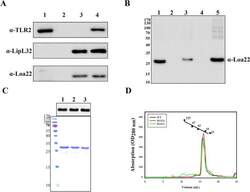
- Experimental details
- Figure 1 Characterization of TLR2 binding proteins from Leptospira . ( A ) Immuno-precipitant of purified TLR2 protein and Loa22 protein. Anti-TLR2, anti-LipL32 and anti-Loa22 antibodies were used to detect the presence of these proteins. Lane 1: anti-V5 antibody activated Protein A beads incubated with HEK293-TLR2 cell lysate; lane 2: anti-V5 antibody activated Protein A beads incubated with LOMP; lane 3: LOMP; lane 4: Co-IP of TLR2 and LOMP fractions. ( B ) The expression of Loa22 protein in different species and fractions of Leptospira . Recombinant Loa22 (rLoa22) was used as positive control (lane 1). Peptidoglycan from L. santarosai (LPGN) was also used to detect the presence of Loa22 protein (lane 2). LOMPs from different species of Leptospires were used to detect the presence or absence of Loa22 protein including pathogenic L. interrogans (lane 3), non-pathogenic L. biflexa (lane 4), and L. santarosai (lane 5). Rabbit polyclone anti-Loa22 antibody was use to recognize the protein. ( C ) Purification of the Loa22 and mutation variants. Wild type and mutation variants were analyzed by SDS-PAGE (lower panel) and Western blot (upper panel; recognized by anti 6XHis tag antibody) Lane 1: WT Loa222; lane 2; Loa22D122A; lane 3: Loa22R143A. ( D ) Size exclusion chromatography of purified Loa22 protein. The single peak of purified Loa22 protein with molecular mass about 22 kDa indicated that the protein was of uniform conformation. The standard markers were ferritin (440 kDa), b
- Submitted by
- Invitrogen Antibodies (provider)
- Main image
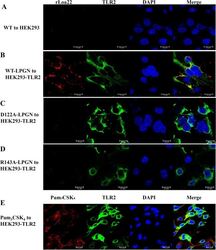
- Experimental details
- Figure 3 Loa22 co-localized with TLR2 on HEK293-TLR2 cells. HEK293-TLR2 cell were cultured to 70% confluence and serum free for 16 h before adding the stimulation agents (0.1 mug/ml). The cells were incubated with the stimulation agents for 4 h and then fixed to against with the anti-V5 antibody (1:5000), anti-Loa22 antibody (1:10,000). The relative Alex488 and Alex594 conjugated secondary antibodies were used to stained TLR2 and Loa22 proteins, respectively. ( A ) rLoa22WT was incubated with HEK293 cell. ( B ) rLoa22WT-LPGN was incubated with HEK293-TLR2 cell. ( C ) rLoa22D122A-LPGN was incubated with HEK293-TLR2 cell. ( D ) rLoa22R143A-LPGN was incubated with HEK293-TLR2 cell. ( E ) Pam 3 CSK 4 Rhodamine was incubated with HEK293-TLR2 cell. The nucleus was stained by DAPI (blue) and TLR2 was stained by Alexa488 (green). Loa22 was stained by Alexa594 (red). The yellow color indicated that the two proteins were co-localized in HEK293-TLR2 cell.
- Submitted by
- Invitrogen Antibodies (provider)
- Main image
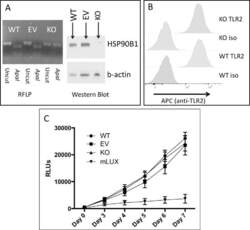
- Experimental details
- 10.1371/journal.pone.0208940.g004 Fig 4 HSP90B1 knock down does not alter TLR2 surface expression or Mtb replication. Using CRISPR/Cas9, HSP90B1 was targeted for gene deletion in U937 macrophage-like human cells. A: Confirmation of knockout. Restriction fragment length polymorphism (RFLP) verified the loss of the ApaI restriction endonuclease site in the targeted lines (KO) but not the wild type (WT) nor cell line exposed to the CRISPR apparatus with a nonspecific guide sequence (EV). Western blot revealed reduction of the expected band in the KO line (b-actin as loading control). B: Wildtype or HSP90B1 knock down cell lines were stained with anti-TLR2 antibody or isotype control (iso) and evaluated for surface expression using flow cytometry. C: Knock down or control cell lines were infected with Erdman strain Mtb constitutively expressing luciferase at a multiplicity of infection of 5. Relative light units (RLUs) act as a proxy for colony count in this assay. Daily RLUs were measured from day 3 to day 7. Included is a background control where the Mtb was added to wells in the absence of human cells (mLux). Each exposure was repeated in sextuplet and the mean and standard deviation are provided for each cell line and time point.
- Submitted by
- Invitrogen Antibodies (provider)
- Main image
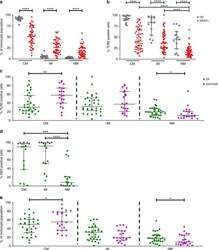
- Experimental details
- Fig. 1 Sustained high expression of TLR2 and increased frequency of monocytes correlates with DENV disease severity. a - e PBMCs were isolated from 15 age-matched healthy donors (HD) and 54 patients undergoing acute DENV infection (DENV+) who developed relatively mild (DF, n = 32) or severe (DHF/DSS, n = 22) disease. a Monocyte subsets distribution in healthy and DENV+ patients (two-tailed Mann-Whitney test, **** P < 0.0001). b Percentages of cells expressing TLR2 were determined for each monocyte subset (two-tailed Mann-Whitney test, **** P < 0.0001) and c stratified by disease severity (two-tailed Mann-Whitney test, * P < 0.05; ** P < 0.01). d Percentages of NS3+ infected cells in DENV-positive patients ( n = 15) stained intracellularly for DENV NS3 (two-tailed Mann-Whitney test, *** P < 0.001; **** P < 0.0001). e Monocyte subsets distribution in patients, stratified by disease severity (two-tailed Mann-Whitney test, * P < 0.05). CM classical monocytes, IM intermediate monocytes, NM non-classical monocytes. Bars represent median with interquartile range (IQR). Source data are provided as a Source data file.
- Submitted by
- Invitrogen Antibodies (provider)
- Main image
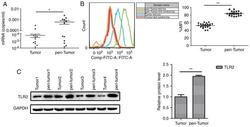
- Experimental details
- Figure 1. TLR2 expression in tumor and the peritumoral tissues from HCC patients. (A) Quantitative PCR, (B) flow cytometry and (C) western blot analysis of TLR2 expression. *P
- Submitted by
- Invitrogen Antibodies (provider)
- Main image
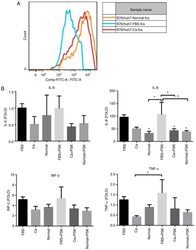
- Experimental details
- Figure 2. (A) TLR2 expression in the B76/Huh7 cell line at 48 h following culture with the serum of patients with HCC (Ca), the serum of healthy individuals (normal) or FBS by flow cytometry. (B) IL-6, IL-8, interferon (INF)-beta and tumor necrosis factor (TNF)-alpha in B76/Huh7 cell line 48 h after culture with the serum of patients with hepatocellular carcinoma, with the serum of healthy individuals or FBS. Reverse transcription-quantitative PCR was performed with the fold change of IL-6 in the cells supplemented with FBS as the positive internal control. The data for the samples are expressed relative to the average value of the control samples +- standard deviations of the means. *P
- Submitted by
- Invitrogen Antibodies (provider)
- Main image
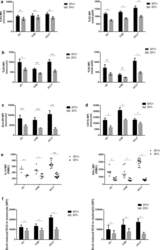
- Experimental details
- Fig. 5 Characterization of EP2-positive immune cells. a - d Peripheral whole blood (at least 5 subjects per group) was stained with anti-CD14, anti-CD16, anti-EP2, anti-TLR2, anti-HLA-DR, anti-CD11b or anti-TLR4. The percentages of different phenotypes of EP2 + or EP2 - monocytes and neutrophils were determined by flow cytometry. e PBMCs isolated from at least 3 subjects per group were stimulated with LPS (100 ng/ml) for 72 h. Cytokine production was measured by flow cytometry. f Peripheral whole blood from 7 subjects per group was incubated with E. coli for 30 min. ROS production in neutrophils and monocytes was assessed by flow cytometry. The data are expressed as the mean +- SEM of individual subjects or plots of individual data. The error bar represented SEM and the horizontal line represented the median. Statistical analyses were analyzed using the Wilcoxon signed-rank test. *p < 0.05, **p < 0.01, ***p < 0.001; ns, not statistically significant
 Explore
Explore Validate
Validate Learn
Learn Western blot
Western blot Flow cytometry
Flow cytometry